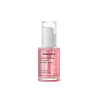What's inside
What's inside
 Key Ingredients
Key Ingredients

 Benefits
Benefits

 Concerns
Concerns

No concerns
 Ingredients Side-by-side
Ingredients Side-by-side

Water
Skin ConditioningCocamidopropyl Betaine
CleansingGlycerin
HumectantSodium Cocoyl Glutamate
CleansingXylitylglucoside
HumectantPentylene Glycol
Skin ConditioningXylitol
HumectantAnhydroxylitol
HumectantUrea
BufferingZinc PCA
HumectantTocopherol
AntioxidantCoco-Glucoside
CleansingGlyceryl Oleate
EmollientCapryloyl Glycine
CleansingParfum
MaskingTetrasodium Glutamate Diacetate
Propylene Glycol
HumectantHydrogenated Palm Glycerides Citrate
EmollientEthylhexylglycerin
Skin ConditioningCitric Acid
BufferingO-Cymen-5-Ol
AntimicrobialSodium Benzoate
MaskingWater, Cocamidopropyl Betaine, Glycerin, Sodium Cocoyl Glutamate, Xylitylglucoside, Pentylene Glycol, Xylitol, Anhydroxylitol, Urea, Zinc PCA, Tocopherol, Coco-Glucoside, Glyceryl Oleate, Capryloyl Glycine, Parfum, Tetrasodium Glutamate Diacetate, Propylene Glycol, Hydrogenated Palm Glycerides Citrate, Ethylhexylglycerin, Citric Acid, O-Cymen-5-Ol, Sodium Benzoate
Collagen Water
HumectantWater
Skin ConditioningGlycerin
HumectantTripropylene Glycol
AntioxidantNiacinamide
SmoothingTrehalose
HumectantSodium Polyacryloyldimethyl Taurate
Emulsion StabilisingButylene Glycol
HumectantAllantoin
Skin ConditioningPolyglyceryl-10 Laurate
Skin ConditioningSodium Polyacrylate
AbsorbentEthylhexylglycerin
Skin ConditioningHydrolyzed Hyaluronic Acid
HumectantAdenosine
Skin ConditioningXanthan Gum
EmulsifyingPolyquaternium-51
Skin ConditioningDisodium EDTA
Glyceryl Acrylate/Acrylic Acid Copolymer
HumectantCaprylyl Glycol
EmollientPvm/Ma Copolymer
Emulsion StabilisingCyanocobalamin
Skin ConditioningCoptis Japonica Root Extract
Skin ConditioningSodium Hyaluronate
HumectantHydroxypropyltrimonium Hyaluronate
Tocopherol
AntioxidantPropanediol
SolventSaccharide Isomerate
HumectantSodium Acetylated Hyaluronate
HumectantCollagen Extract
Skin ConditioningHyaluronic Acid
HumectantHydrolyzed Sodium Hyaluronate
Skin ConditioningSodium Hyaluronate Crosspolymer
HumectantAlginic Acid
Skin ConditioningSilanetriol
Potassium Hyaluronate
Skin ConditioningHydrolyzed Elastin
EmollientElastin
Skin ConditioningSoluble Elastin
Skin ConditioningTripeptide-1
Skin ConditioningAcetyl Hexapeptide-8
HumectantCopper Tripeptide-1
Skin ConditioningPalmitoyl Tripeptide-5
Skin ConditioningSh-Oligopeptide-1
Skin ConditioningPentapeptide-4
Skin ConditioningPalmitoyl Tripeptide-38
Skin ConditioningHexapeptide-9
Skin ConditioningHexapeptide-12
Skin ConditioningPalmitoyl Pentapeptide-4
Skin ConditioningCollagen Water, Water, Glycerin, Tripropylene Glycol, Niacinamide, Trehalose, Sodium Polyacryloyldimethyl Taurate, Butylene Glycol, Allantoin, Polyglyceryl-10 Laurate, Sodium Polyacrylate, Ethylhexylglycerin, Hydrolyzed Hyaluronic Acid, Adenosine, Xanthan Gum, Polyquaternium-51, Disodium EDTA, Glyceryl Acrylate/Acrylic Acid Copolymer, Caprylyl Glycol, Pvm/Ma Copolymer, Cyanocobalamin, Coptis Japonica Root Extract, Sodium Hyaluronate, Hydroxypropyltrimonium Hyaluronate, Tocopherol, Propanediol, Saccharide Isomerate, Sodium Acetylated Hyaluronate, Collagen Extract, Hyaluronic Acid, Hydrolyzed Sodium Hyaluronate, Sodium Hyaluronate Crosspolymer, Alginic Acid, Silanetriol, Potassium Hyaluronate, Hydrolyzed Elastin, Elastin, Soluble Elastin, Tripeptide-1, Acetyl Hexapeptide-8, Copper Tripeptide-1, Palmitoyl Tripeptide-5, Sh-Oligopeptide-1, Pentapeptide-4, Palmitoyl Tripeptide-38, Hexapeptide-9, Hexapeptide-12, Palmitoyl Pentapeptide-4
Ingredients Explained
These ingredients are found in both products.
Ingredients higher up in an ingredient list are typically present in a larger amount.
Ethylhexylglycerin (we can't pronounce this either) is commonly used as a preservative and skin softener. It is derived from glyceryl.
You might see Ethylhexylglycerin often paired with other preservatives such as phenoxyethanol. Ethylhexylglycerin has been found to increase the effectiveness of these other preservatives.
Glycerin is already naturally found in your skin. It helps moisturize and protect your skin.
A study from 2016 found glycerin to be more effective as a humectant than AHAs and hyaluronic acid.
As a humectant, it helps the skin stay hydrated by pulling moisture to your skin. The low molecular weight of glycerin allows it to pull moisture into the deeper layers of your skin.
Hydrated skin improves your skin barrier; Your skin barrier helps protect against irritants and bacteria.
Glycerin has also been found to have antimicrobial and antiviral properties. Due to these properties, glycerin is often used in wound and burn treatments.
In cosmetics, glycerin is usually derived from plants such as soybean or palm. However, it can also be sourced from animals, such as tallow or animal fat.
This ingredient is organic, colorless, odorless, and non-toxic.
Glycerin is the name for this ingredient in American English. British English uses Glycerol/Glycerine.
Learn more about GlycerinTocopherol (also known as Vitamin E) is a common antioxidant used to help protect the skin from free-radicals and strengthen the skin barrier. It's also fat soluble - this means our skin is great at absorbing it.
Vitamin E also helps keep your natural skin lipids healthy. Your lipid skin barrier naturally consists of lipids, ceramides, and fatty acids. Vitamin E offers extra protection for your skin’s lipid barrier, keeping your skin healthy and nourished.
Another benefit is a bit of UV protection. Vitamin E helps reduce the damage caused by UVB rays. (It should not replace your sunscreen). Combining it with Vitamin C can decrease sunburned cells and hyperpigmentation after UV exposure.
You might have noticed Vitamin E + C often paired together. This is because it is great at stabilizing Vitamin C. Using the two together helps increase the effectiveness of both ingredients.
There are often claims that Vitamin E can reduce/prevent scarring, but these claims haven't been confirmed by scientific research.
Learn more about TocopherolWater. It's the most common cosmetic ingredient of all. You'll usually see it at the top of ingredient lists, meaning that it makes up the largest part of the product.
So why is it so popular? Water most often acts as a solvent - this means that it helps dissolve other ingredients into the formulation.
You'll also recognize water as that liquid we all need to stay alive. If you see this, drink a glass of water. Stay hydrated!
Learn more about Water